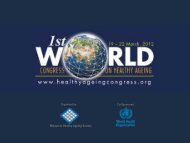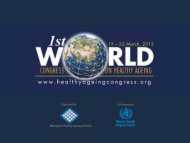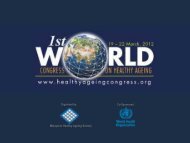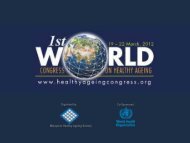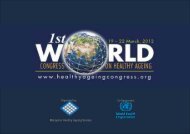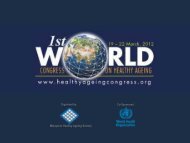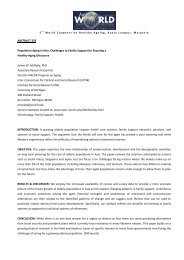Giants of Geriatrics - 1st World Congress on Healthy Ageing
Giants of Geriatrics - 1st World Congress on Healthy Ageing
Giants of Geriatrics - 1st World Congress on Healthy Ageing
You also want an ePaper? Increase the reach of your titles
YUMPU automatically turns print PDFs into web optimized ePapers that Google loves.
Organised by:<br />
Co-Sp<strong>on</strong>sored:<br />
Malaysian <strong>Healthy</strong> <strong>Ageing</strong> Society
<str<strong>on</strong>g>Giants</str<strong>on</strong>g> <str<strong>on</strong>g>of</str<strong>on</strong>g> <str<strong>on</strong>g>Geriatrics</str<strong>on</strong>g>-Current<br />
Issues and Challenges<br />
Dr.P.SRINIVAS<br />
CONSULTANT GERIATRICIAN/PHYSICIAN<br />
GLENEAGLES MEDICAL CENTRE<br />
PENANG, MALAYSIA
FACING THE GIANTS OF<br />
GERIATRICS
GERIATRICS(Nascher1909)<br />
• Geriatric Medicine is that branch <str<strong>on</strong>g>of</str<strong>on</strong>g><br />
general medicine c<strong>on</strong>cerned with the<br />
clinical, preventive, remedial and social<br />
aspects <str<strong>on</strong>g>of</str<strong>on</strong>g> illness <str<strong>on</strong>g>of</str<strong>on</strong>g> older people<br />
• Older people <str<strong>on</strong>g>of</str<strong>on</strong>g>ten have multiple medical<br />
problems, different patterns <str<strong>on</strong>g>of</str<strong>on</strong>g> disease<br />
presentati<strong>on</strong>, <str<strong>on</strong>g>of</str<strong>on</strong>g>ten slower resp<strong>on</strong>se to<br />
treatment and requirements for social<br />
support, calls for special medical skills!
Elderly –pers<strong>on</strong>s aged 65 yrs and<br />
• How are they different?<br />
• Multiple pathology<br />
above(W.H.0.)<br />
• N<strong>on</strong>-specific presentati<strong>on</strong> <str<strong>on</strong>g>of</str<strong>on</strong>g> disease<br />
• Rapid decline if not treated early<br />
• High incidence <str<strong>on</strong>g>of</str<strong>on</strong>g> sec<strong>on</strong>dary complicati<strong>on</strong>s<br />
<str<strong>on</strong>g>of</str<strong>on</strong>g> disease and treatment<br />
• Need for rehabilitati<strong>on</strong><br />
• Importance <str<strong>on</strong>g>of</str<strong>on</strong>g> social and envir<strong>on</strong>mental<br />
factors
Ger<strong>on</strong>tology<br />
• Ger<strong>on</strong>tology comes from the Greek word<br />
“Geras” meaning old age and “Logo”<br />
meaning Study<br />
• Ger<strong>on</strong>tology is the scientific study <str<strong>on</strong>g>of</str<strong>on</strong>g> the<br />
phenomen<strong>on</strong> associated with ageing<br />
• <str<strong>on</strong>g>Geriatrics</str<strong>on</strong>g> is subdiscipline <str<strong>on</strong>g>of</str<strong>on</strong>g> Ger<strong>on</strong>tology<br />
which is related to the medical aspects <str<strong>on</strong>g>of</str<strong>on</strong>g><br />
ageing
Aims <str<strong>on</strong>g>of</str<strong>on</strong>g> Geriatric Medicine<br />
1. To enable elderly people lead full and active<br />
lives<br />
2. To prevent disease or to detect and treat it early<br />
3. To reduce suffering due to disability and disease<br />
and minimise dependence by proper<br />
rehabilitati<strong>on</strong><br />
4. To provide a holistic medical care and arrange<br />
for adequate social support when needed<br />
5.To manage “Geriatric <str<strong>on</strong>g>Giants</str<strong>on</strong>g>” :Inc<strong>on</strong>tinence,<br />
Immobilty, Instability(falls),Intellectual<br />
impairment(dementia)
<str<strong>on</strong>g>Giants</str<strong>on</strong>g> <str<strong>on</strong>g>of</str<strong>on</strong>g> <str<strong>on</strong>g>Geriatrics</str<strong>on</strong>g><br />
• <str<strong>on</strong>g>Giants</str<strong>on</strong>g> <str<strong>on</strong>g>of</str<strong>on</strong>g> geriatrics was a term coined by<br />
the late Pr<str<strong>on</strong>g>of</str<strong>on</strong>g>. Bernard Isaacs to highlight<br />
the major illnesses associated with ageing<br />
• Although the major causes <str<strong>on</strong>g>of</str<strong>on</strong>g> mortality in<br />
the elderly are cancers ,heart disease and<br />
stroke, The Geriatric <str<strong>on</strong>g>Giants</str<strong>on</strong>g> reflected the<br />
gigantic numbers <str<strong>on</strong>g>of</str<strong>on</strong>g> elderly afflicted and<br />
the giant <strong>on</strong>slaught <strong>on</strong> the independence<br />
<str<strong>on</strong>g>of</str<strong>on</strong>g> the victims!
GIANTS OF GERIATRICS<br />
• IMMOBILITY<br />
• INSTABILITY<br />
• INCONTINENCE<br />
• INTELECTUAL IMPAIRMENT<br />
• IATROGENIC
IMMOBILITY<br />
• Defined as the impairment <str<strong>on</strong>g>of</str<strong>on</strong>g> the ability to move<br />
independently which results in the limitati<strong>on</strong> <str<strong>on</strong>g>of</str<strong>on</strong>g> lifespace.<br />
• This difficulty or the inability to perform mobility tasks is<br />
an important outcome to disease and a public health<br />
problem in older people.<br />
• Functi<strong>on</strong>al assessment <str<strong>on</strong>g>of</str<strong>on</strong>g> elderly patients is very<br />
important in a comprehensive geriatric assessment and<br />
management <str<strong>on</strong>g>of</str<strong>on</strong>g> the patient in a holistic manner.
IMMOBILITY<br />
<str<strong>on</strong>g>of</str<strong>on</strong>g>ten multifactorial<br />
• Musculoskeletal-OA----pain, muscle<br />
weakness and dec<strong>on</strong>diti<strong>on</strong>ing<br />
• Heart disease/COPD---CCF----SOB and<br />
loss <str<strong>on</strong>g>of</str<strong>on</strong>g> work ability<br />
• CNS-Stroke—muscle weakness,abnormal<br />
gait ,poor propriocepti<strong>on</strong><br />
• Cataracts-Macular degenerati<strong>on</strong>-poor<br />
visi<strong>on</strong> and falls
IMMOBILITY<br />
Implicati<strong>on</strong>s<br />
• Adversely affects the quality <str<strong>on</strong>g>of</str<strong>on</strong>g> life <str<strong>on</strong>g>of</str<strong>on</strong>g> older people<br />
• Threatens their independence and pers<strong>on</strong>al aut<strong>on</strong>omy<br />
• Increases both the informal and formal career needs and<br />
hence a ‘burden to society’<br />
• Inactivity increases the risks <str<strong>on</strong>g>of</str<strong>on</strong>g> inc<strong>on</strong>tinence, pressure<br />
ulcers, deep vein thrombosis, osteoporosis and<br />
pulm<strong>on</strong>ary embolism<br />
• Increases the risks <str<strong>on</strong>g>of</str<strong>on</strong>g> muscular weakness ,lowered<br />
aerobic capacity and finally leading to poor physical<br />
capacity or dec<strong>on</strong>diti<strong>on</strong>ing
• Impaired Mobility in Older Pers<strong>on</strong>s<br />
• Attending a Geriatric Assessment Clinic:<br />
• Causes and Management<br />
• T L Tan et al Singapore Med Journal 2010<br />
•Impaired mobility is a comm<strong>on</strong><br />
pathway for many diseases, and is associated<br />
with significant functi<strong>on</strong>al decline.<br />
•With proper evaluati<strong>on</strong>, the <str<strong>on</strong>g>of</str<strong>on</strong>g>fending causes<br />
can be identified.<br />
•Early c<strong>on</strong>sultati<strong>on</strong> is important for the<br />
applicati<strong>on</strong> <str<strong>on</strong>g>of</str<strong>on</strong>g> appropriate interventi<strong>on</strong> and can<br />
result in better outcome.
Rehab:Physical and Occupati<strong>on</strong>al
IMPROVING MOBILITY
Science News April 2010<br />
... Domestic Robot to Help Sick Elderly Live<br />
Independently L<strong>on</strong>ger<br />
• To enable elderly people to live at home as l<strong>on</strong>g as possible, a<br />
group <str<strong>on</strong>g>of</str<strong>on</strong>g> European researchers, coordinated from Eindhoven<br />
University <str<strong>on</strong>g>of</str<strong>on</strong>g> Technology (TU/e), will link robots and 'smart homes'.<br />
• The robot, a 'sensible family friend', will ensure that home is a nice<br />
place to stay.<br />
• The recently started research project, which has been named<br />
KSERA (Knowledgeable Service Robots for Aging) focuses in<br />
particular <strong>on</strong> COPD patients, people with chr<strong>on</strong>ic obstructive<br />
pulm<strong>on</strong>ary disease.<br />
• In 2030 this disease will be the third cause <str<strong>on</strong>g>of</str<strong>on</strong>g> death worldwide,<br />
according to expectati<strong>on</strong>s <str<strong>on</strong>g>of</str<strong>on</strong>g> the <str<strong>on</strong>g>World</str<strong>on</strong>g> Health Organizati<strong>on</strong>.
• A Nao robot. In the KSERA project this standard<br />
robot will be the starting point. It will be<br />
upgraded and fitted with a projector, so that it<br />
can show pictures. (Credit: Image courtesy <str<strong>on</strong>g>of</str<strong>on</strong>g><br />
Eindhoven University <str<strong>on</strong>g>of</str<strong>on</strong>g> Technology)
Robots caring for elders
Robotics and Video Games Help<br />
Elderly in Rehab<br />
• Centre for Advanced Rehab<br />
Therapeutics(CART) Tan Tock Seng<br />
Hospital , Singapore---Robotics reduce and eliminate<br />
physical loading <strong>on</strong> therapists!<br />
• 70 year old man with a stroke <strong>on</strong> the right side and<br />
immobile for 3 m<strong>on</strong>ths has after intensive physio and use<br />
<str<strong>on</strong>g>of</str<strong>on</strong>g> “Armeo” robotic arm regained some power to move<br />
his right hand up/down and laterally!
CHALLENGES-IMMOBILTY
IMMOBILITY<br />
Case history<br />
• An 85 year old man has a 4cm by 7cm stage 3<br />
pressure ulcer over the sacrum. He has been<br />
c<strong>on</strong>fined to the bed since sustaining a hip<br />
fracture 3 m<strong>on</strong>ths ago and has lost 10 lbs.<br />
during this time. Examinati<strong>on</strong> shows a foul<br />
smelling wound,necrotic tissue covering 50% <str<strong>on</strong>g>of</str<strong>on</strong>g><br />
the ulcer and purulent drainage at the base.<br />
There is no cellulitis—apart from surgical<br />
debridement ---what is the appropriate<br />
,management?
IMMOBILITY<br />
Case history<br />
• Good nutriti<strong>on</strong>—calcium, zinc ,protein intake and<br />
management <str<strong>on</strong>g>of</str<strong>on</strong>g> osteoporosis<br />
• Good medical care and comfortable positi<strong>on</strong>ing, 2<br />
hourly turning and alternating pressure mattresses<br />
• Osteomyelitis, bacteremia and deep vein thrombosis are<br />
complicati<strong>on</strong>s and iv antibiotics and prophylactic<br />
anticoagulati<strong>on</strong> may be required<br />
• After adequate debridement and removal <str<strong>on</strong>g>of</str<strong>on</strong>g> necrotic<br />
tissue <strong>on</strong>ly then adhesive polyurethane dressings and<br />
myocutaneous flap can be c<strong>on</strong>sidered.
INCONTINENCE<br />
• A c<strong>on</strong>diti<strong>on</strong> <str<strong>on</strong>g>of</str<strong>on</strong>g> involuntary loss <str<strong>on</strong>g>of</str<strong>on</strong>g> urine that is a social or<br />
hygienic problem and is objectively dem<strong>on</strong>strable.<br />
• <strong>Ageing</strong> causes smaller bladder capacity and greater<br />
night time GFR ---more nocturia in elderly<br />
• Males –urethra obstructed by prostate gland—females<br />
the urethra may be traumatised by frequent pregnancies<br />
• Kidneys become less resp<strong>on</strong>sive to sodium loss and to<br />
ADH –hence the kidneys are less able to c<strong>on</strong>centrate the<br />
urine.
INCONTINENCE<br />
• Adequate functi<strong>on</strong> <str<strong>on</strong>g>of</str<strong>on</strong>g> the lower urinary tract to store and<br />
empty urine<br />
• Adequate mental functi<strong>on</strong><br />
• Sufficient mobility and dexterity to get to the toilet and<br />
manage the clothing<br />
• Motivati<strong>on</strong> to be c<strong>on</strong>tinent<br />
• Absence <str<strong>on</strong>g>of</str<strong>on</strong>g> envir<strong>on</strong>mental/iatrogenic barriers to<br />
c<strong>on</strong>tinence<br />
ALL THE ABOVE FACTORS MUST BE IDENTIFIED<br />
SO THAT APPROPRIATE MANAGEMENT OF PATIENT!
ACUTE INCONTINENCE<br />
• Delirium<br />
• R estricted mobility<br />
• Infecti<strong>on</strong>,inflammati<strong>on</strong>,impacti<strong>on</strong><br />
• P harmacueticals, polyuria
PERSISTENT INCONTINENCE<br />
• STRESS: the involuntary loss <str<strong>on</strong>g>of</str<strong>on</strong>g> urine during the act <str<strong>on</strong>g>of</str<strong>on</strong>g><br />
laughing, coughing or exercise<br />
• URGE: Leakage <str<strong>on</strong>g>of</str<strong>on</strong>g> urine because <str<strong>on</strong>g>of</str<strong>on</strong>g> the inability to delay<br />
voiding after the sensati<strong>on</strong> <str<strong>on</strong>g>of</str<strong>on</strong>g> bladder fullness is<br />
perceived. “ Must go now!!!! Or “ I cannot make it to the<br />
toilet <strong>on</strong> time” are comm<strong>on</strong> complaints.<br />
• OVERFLOW(NEUROGENIC): Frequent dribbling <str<strong>on</strong>g>of</str<strong>on</strong>g><br />
urine, usually after a stroke or BPH<br />
• FUNCTIONAL: Due to physical and cognitive impairment<br />
Dementia, depressi<strong>on</strong>, inaccessible toilet facilities.
INCONTINENCE<br />
• History: medicati<strong>on</strong>s, mental state, mobility<br />
• Physical: CNS, lumbosacral spine, abdomen—<br />
palpable bladder, rectal exam, and vaginal exam<br />
• Post voidal residual urine : >100 MLS –needs<br />
further investigati<strong>on</strong>s and refer for urodynamic<br />
studies---can check for detrusor instability and<br />
compliance <str<strong>on</strong>g>of</str<strong>on</strong>g> urethra<br />
• Urine for microscopy and culture
INCONTINENCE<br />
• Identify and treat c<strong>on</strong>tributing factors—medicati<strong>on</strong>s—<br />
diuretic, tricyclics, anticholinergics, excessive c<str<strong>on</strong>g>of</str<strong>on</strong>g>fee and<br />
tea or alcohol intake.<br />
• Infecti<strong>on</strong> with appropriate antibiotics<br />
• Atrophic vaginitis—treat with oestrogen cream<br />
• Pelvic floor or Kegel exercise, Bladder retraining,<br />
behavioral methods<br />
• Remove barriers<br />
• Medicati<strong>on</strong>s : oxybutinin (direct smooth muscle<br />
relaxati<strong>on</strong>), detrusitol, propiverine hydrochloride<br />
• Devices:Catheters—accurate m<strong>on</strong>itoring <str<strong>on</strong>g>of</str<strong>on</strong>g> urine output,<br />
urinary retenti<strong>on</strong>(BPH), perineal and sacral pressure<br />
ulcers, terminal illness. Inc<strong>on</strong>tinence pads best in stress<br />
inc<strong>on</strong>tinence and also as an adjunct
INCONTINENCE<br />
• Remember that indwelling catheters used <strong>on</strong>ly after<br />
other therapies have been exhausted<br />
• External sheaths or c<strong>on</strong>dom catheters can be tried—not<br />
useful in acute urinary redetecti<strong>on</strong><br />
• Intermittent catheterisati<strong>on</strong> in the younger inc<strong>on</strong>tinent<br />
• Inc<strong>on</strong>tinence carries a HUGE social stigma, reduces life<br />
space and mobility and is a huge financial and social<br />
burden to the carers<br />
• In the management few can be cured, many can be<br />
improved and all can be better understood.
GIANTS OF GERIATRICS<br />
• IMMOBILITY<br />
• INSTABILITY<br />
• INCONTINENCE<br />
• INTELECTUAL IMPAIRMENT<br />
• IATROGENIC
FALLS IN THE ELDERLY
FALLS<br />
Fall defined as a subject unintenti<strong>on</strong>ally coming to rest<br />
<strong>on</strong> the ground, not as a result <str<strong>on</strong>g>of</str<strong>on</strong>g> a major intrinsic event<br />
(e.g.. stroke , syncope) or overwhelming hazard<br />
•Falls are comm<strong>on</strong> and preventable source <str<strong>on</strong>g>of</str<strong>on</strong>g> mortality and<br />
morbidity in the elderly.<br />
•The highest mortality are from falls <strong>on</strong> or from stairs particularly in<br />
the age group <str<strong>on</strong>g>of</str<strong>on</strong>g> 85 years and over.<br />
•Most falls multifactorial in origin resulting from<br />
stability impairment features <str<strong>on</strong>g>of</str<strong>on</strong>g> the host(intrinsic) and extrinsic<br />
causes in the envir<strong>on</strong>ment
•Major sequelae and morbidity <str<strong>on</strong>g>of</str<strong>on</strong>g> falls<br />
•is hip fractures (more comm<strong>on</strong> in<br />
women<br />
with osteoporosis).<br />
•Inability to get up without help.<br />
•Fear <str<strong>on</strong>g>of</str<strong>on</strong>g> falling and loss <str<strong>on</strong>g>of</str<strong>on</strong>g> c<strong>on</strong>fidence.
INCIDENCE OF ELDERLY<br />
SUSTAINING<br />
FALLS IN THE COMMUNITY<br />
MARKEDLY INCREASES WITH AGE<br />
25% AT 70 YEARS OF AGE<br />
35% AT > 75 YEARS OF AGE<br />
• NURSING HOMES : 40% OF ADMISSIONS<br />
WERE DUE TO FALLS<br />
• STUDY BY TINETTI et al;<br />
1 year prospective followup <str<strong>on</strong>g>of</str<strong>on</strong>g> 336 pers<strong>on</strong>s aged<br />
75 years and above 32% fell at least <strong>on</strong>ce<br />
24% had serious injuries<br />
6% had fractures
Risk factors - affecting stability<br />
1. Sensory :<br />
Visi<strong>on</strong>, hearing, vestibular functi<strong>on</strong><br />
and propriocepti<strong>on</strong><br />
2. CNS - problems in central integrati<strong>on</strong><br />
3. Dementia - cognitive functi<strong>on</strong> decline<br />
4. Musculoskeletal<br />
5. Medicati<strong>on</strong>s
Factors which precipitate falls<br />
Majority occurs during ordinary walking, stepping<br />
up or down and while changing positi<strong>on</strong><br />
70% --- FALLS AT HOME<br />
10% --- STAIRS DESCENDING<br />
5% --- CLIMBING CHAIRS OR LADDERS<br />
Envir<strong>on</strong>mental hazards present in 50% <str<strong>on</strong>g>of</str<strong>on</strong>g> falls<br />
Visual percepti<strong>on</strong> problems are comm<strong>on</strong> in old age
RISK FACTORS FOR<br />
FALLS<br />
RISK FACTOR ADJUSTED ODDS RATIO 95% CI<br />
Use <str<strong>on</strong>g>of</str<strong>on</strong>g> sedatives 28.3 3.4 - 239.4<br />
Cognitive impairment 5.0 1.8 - 13.7<br />
Lower-extremity disability 3.8 2.2 - 6.7<br />
Palmomental reflex 3.0 1.5 - 6.1<br />
Foot problems 1.8 1.0 - 3.1<br />
No. <str<strong>on</strong>g>of</str<strong>on</strong>g> balance-and-gait abnormalities<br />
0-2 1.0 ---<br />
3-5 1.4 0.7 - 2.8<br />
6-7 1.9 1.0 - 3.7<br />
CI denotes c<strong>on</strong>fidence interval. Adjusted odds ratios were obtained<br />
from multiple logistic-regressi<strong>on</strong> analysis
Percent Falling<br />
Occurrence <str<strong>on</strong>g>of</str<strong>on</strong>g> Falls According to the Number <str<strong>on</strong>g>of</str<strong>on</strong>g><br />
Risk<br />
factors<br />
100<br />
78%<br />
80<br />
60%<br />
60<br />
40<br />
32%<br />
19%<br />
20<br />
8%<br />
0<br />
0 1 2 3 4+<br />
Number <str<strong>on</strong>g>of</str<strong>on</strong>g> risk factors<br />
No. Falling<br />
No. Subjects<br />
4<br />
51<br />
20<br />
106<br />
30<br />
94<br />
35<br />
58<br />
18<br />
23
Medical causes <str<strong>on</strong>g>of</str<strong>on</strong>g> falls<br />
System/category<br />
Cardiovascular<br />
Respiratory<br />
Gastrointestinal<br />
Genitourinary<br />
Endocrine<br />
Examples<br />
Acute myocardial infarct<br />
Arrhythmias<br />
Postural hypotensi<strong>on</strong><br />
Pulm<strong>on</strong>ary embolus<br />
Chest infecti<strong>on</strong><br />
Pneumothorax<br />
Hypovolaemia sec<strong>on</strong>dary to<br />
vomiting, diarrhoea or blood loss<br />
Any cause <str<strong>on</strong>g>of</str<strong>on</strong>g> acute abdomen<br />
Urinary tract infecti<strong>on</strong><br />
Micturiti<strong>on</strong> syncope<br />
Hyperthyroidism or hypothyroidism<br />
Hyperglycaemia or hypoglycaemia<br />
Addis<strong>on</strong>’s disease # 1
Medical causes <str<strong>on</strong>g>of</str<strong>on</strong>g><br />
falls<br />
System/category<br />
Examples<br />
Drugs Most drug categories are associated<br />
with falls, particularly hypnotics,<br />
psychotropics diuretics, antihypertensives<br />
Polypharmacy/certain drug<br />
combinati<strong>on</strong>s (e.g. diuretic + tricyclic<br />
antidepressants) are associated with<br />
significantly increased risk<br />
# 3
WHAT CAUSED THE FALL?<br />
• Was there loss <str<strong>on</strong>g>of</str<strong>on</strong>g> c<strong>on</strong>sciousness?<br />
• Was the patient dizzy?<br />
• Was there an acute illness?<br />
• Was there any warning?<br />
IF NO TO ALL THE ABOVE - FALLS<br />
OFTEN MULTIFACTORIAL AND/OR FALL<br />
CAUSED BY LOWER LIMB WEAKNESS
MULTIFACTORIAL<br />
INTERVENTION TO REDUCE<br />
THE RISK OF FALLING IN THE<br />
COMMUNITY<br />
Tinetti et al, 331 No 13, 1994<br />
NEJM
TARGETED RISK FACTOR<br />
• Postural Hypotensi<strong>on</strong><br />
• Use <str<strong>on</strong>g>of</str<strong>on</strong>g> sedative hypnotic<br />
• 4 prescripti<strong>on</strong> meds<br />
• Unable to transfer safely<br />
• Gait impairment<br />
• Impaired muscle strength
SCREENING FOR PEOPLE AT RISK<br />
• L<strong>on</strong>g acting sedatives<br />
• Mother with hip fracture<br />
• Previous fracture<br />
• Decreased mobility<br />
• > 2 cups c<str<strong>on</strong>g>of</str<strong>on</strong>g>fee/day<br />
• Previous hyperthyroidism<br />
• Poor general health
RISK FEATURES CONTINUED<br />
• Failed “Get up & go” test<br />
• Decreased visi<strong>on</strong><br />
• Resting tachycardia<br />
• Low calcaneal BMD
CHALLENGES-FALLS
PREVENTION OF FALLS(1)<br />
• Older people who have had recurrent falls should be<br />
<str<strong>on</strong>g>of</str<strong>on</strong>g>fered l<strong>on</strong>g term exercise and gait/balance training<br />
• Tai Chi is a promising type <str<strong>on</strong>g>of</str<strong>on</strong>g> balance exercise –reduced<br />
the risk <str<strong>on</strong>g>of</str<strong>on</strong>g> falls during a short period <str<strong>on</strong>g>of</str<strong>on</strong>g> 4 m<strong>on</strong>ths<br />
• When older people at increased falls are discharged<br />
from hospital an envir<strong>on</strong>mental home assessment<br />
should be c<strong>on</strong>sidered<br />
• Patients who have fallen should have their medicati<strong>on</strong>s<br />
reviewed altered or stopped in light <str<strong>on</strong>g>of</str<strong>on</strong>g> their risk <str<strong>on</strong>g>of</str<strong>on</strong>g> future<br />
falls---especially those <strong>on</strong> 4 or more medicati<strong>on</strong>s and <strong>on</strong><br />
psychotropic drugs.
PREVENTION OF FALLS(2)<br />
• Assistive devices like canes ,walkers or hip<br />
protectors may be effective elements <str<strong>on</strong>g>of</str<strong>on</strong>g> a<br />
multifactorial interventi<strong>on</strong> program<br />
• Cardiovascular interventi<strong>on</strong>s in ruling orthostatic<br />
hypotensi<strong>on</strong>, carotid sinus syndrome and<br />
vasovagal syndrome<br />
• Visual interventi<strong>on</strong>—poor acuity,cataracts,<br />
decreased visual field, reduced c<strong>on</strong>trast<br />
sensitivity needs to be corrected.<br />
• Check foot wear—low heeled—hard soled (low<br />
resistance) are better
FALLS IN THE ELDERLY<br />
• Falls are <str<strong>on</strong>g>of</str<strong>on</strong>g>ten predictable<br />
• Screening the populati<strong>on</strong> at risk may be<br />
cost effective<br />
• Interventi<strong>on</strong> can reduce frequency<br />
• Prophylaxis for fractures essential
" Doctors prescribe drugs<br />
about which they know little,<br />
for diseases about which<br />
they know less,<br />
to patients about whom<br />
they know nothing "<br />
- Voltaire
General Principles<br />
• Elderly 4% <str<strong>on</strong>g>of</str<strong>on</strong>g> populati<strong>on</strong> but c<strong>on</strong>sume<br />
38% <str<strong>on</strong>g>of</str<strong>on</strong>g> prescribed medicati<strong>on</strong>s<br />
• Average elderly in community c<strong>on</strong>sumes<br />
4.5 medicati<strong>on</strong>s<br />
• Elderly in Nursing Homes c<strong>on</strong>sume >7<br />
medicati<strong>on</strong>s
Presc./head<br />
Prescripti<strong>on</strong>s per head in England<br />
1987-97 (Source: DOH, 1998)<br />
25<br />
20<br />
15<br />
10<br />
0-15<br />
16-59/64<br />
>60/65<br />
5<br />
0<br />
1987 1988 1989 1990 1991 1992 1993 1994 1995 1996 1997
Prevalence <str<strong>on</strong>g>of</str<strong>on</strong>g> ADR in relati<strong>on</strong> to<br />
number <str<strong>on</strong>g>of</str<strong>on</strong>g> prescribed drugs<br />
90<br />
ADR Prev (%)<br />
80<br />
70<br />
60<br />
50<br />
40<br />
30<br />
20<br />
10<br />
0<br />
1 2 3 4 5 6<br />
Adverse reacti<strong>on</strong> No adverse reacti<strong>on</strong><br />
No <str<strong>on</strong>g>of</str<strong>on</strong>g> drugs<br />
Williams<strong>on</strong> & Chopin, 1980
300<br />
Gastrointestinal Events per<br />
1000<br />
Pers<strong>on</strong>s in Relati<strong>on</strong> to Age<br />
250<br />
200<br />
150<br />
100<br />
50<br />
0<br />
>49 50-59 60-69 70-79 80-89<br />
NSAID C<strong>on</strong>trol Attr. Risk
8<br />
7<br />
6<br />
5<br />
4<br />
3<br />
2<br />
1<br />
0<br />
Relative risk<br />
Effect <str<strong>on</strong>g>of</str<strong>on</strong>g> dose <strong>on</strong> relative risk <str<strong>on</strong>g>of</str<strong>on</strong>g><br />
peptic ulcer in older NSAID users<br />
0.5 1-1.5 2-2.5 3+<br />
Std Dose Multiple<br />
Griffin et al,<br />
1991
General Principles<br />
• Drugs should be c<strong>on</strong>sidered as potential<br />
cause <str<strong>on</strong>g>of</str<strong>on</strong>g> any symptom<br />
• ADR presents <str<strong>on</strong>g>of</str<strong>on</strong>g>ten atypically and<br />
n<strong>on</strong>specifically as a “geriatric giant”<br />
– C<strong>on</strong>fusi<strong>on</strong> -- delirium, dementia<br />
– Depressi<strong>on</strong><br />
– Falls<br />
– Inc<strong>on</strong>tinence<br />
– Decreased ADL’s
Why are elderly at risk?<br />
• Changes in drug distributi<strong>on</strong> and metabolism<br />
• Multiple symptoms leading to multiple drugs<br />
• Expectati<strong>on</strong>s -- “pill for every ill”<br />
• Over reliance <strong>on</strong> symptoms rather than<br />
emphasis <strong>on</strong> geriatric assessment<br />
• Multiple factors that affect drug adherence in<br />
the elderly
Why are Elderly at Risk?<br />
• Inadequate clinical assessment:n<strong>on</strong>specific<br />
symptoms are treated with drugs<br />
• Excessive prescribing:polypharmacy<br />
• Altered pharmacokinectics and<br />
phamacodynamics <str<strong>on</strong>g>of</str<strong>on</strong>g> drugs in the elderly<br />
• Compliance
CNS DRUGS AND THE ELDERLY<br />
• Major tranquilizers—elderly are particularly vulnerable to<br />
the side effects e.g.. Delirium, extrapyramidal symptoms,<br />
arrythmias, postural hypotensi<strong>on</strong><br />
• Higher incidence <str<strong>on</strong>g>of</str<strong>on</strong>g> tardive dyskinesia and choreiform<br />
side effects<br />
• DIAZEPAM: t ½ life is 20 hours in young but 90 hrs in 80 yr<br />
old(increased Vd)<br />
• LORAZEPAM(10-20 HRS) and OXAZEPAM(5-15 hrs) no<br />
major changes in elderly<br />
• FLURAZEPAM(7 DAYS), TEMAZEPAM(15 HRS)—<br />
Cerebellar and Fr<strong>on</strong>tal Lobe dysfuncti<strong>on</strong>---predispose to<br />
falls in the elderly
Benzodiazepines<br />
• Depressogenic<br />
• Ataxia --- leading to falls and fractures<br />
• C<strong>on</strong>fusi<strong>on</strong><br />
• Disinhibiti<strong>on</strong> -- aggressi<strong>on</strong> & sexually<br />
inappropriate behaviour<br />
• Withdrawal symptoms<br />
• AVOID l<strong>on</strong>g acting Benzo’s such as<br />
diazepam and flurazepam (except maybe in<br />
alcohol withdrawal)
Challenges-Medicati<strong>on</strong>s
RECOMMENDATIONS FOR DRUG<br />
THERAPY IN THE ELDERLY<br />
• Make a diagnoses before initiati<strong>on</strong> <str<strong>on</strong>g>of</str<strong>on</strong>g> multiple drug<br />
therapy. Avoid treating symptoms!<br />
• Begin with a low dose ;simplify the dose and drug<br />
regimens---maximise compliance<br />
• Advise patients <str<strong>on</strong>g>of</str<strong>on</strong>g> any serious drug effects--<br />
?Potential cause <str<strong>on</strong>g>of</str<strong>on</strong>g> new symptoms<br />
• Periodically review the list <str<strong>on</strong>g>of</str<strong>on</strong>g> medicati<strong>on</strong>s and review<br />
the doses that need to be adjusted with increasing<br />
age<br />
• Advanced patient age, in itself should NEVER be<br />
c<strong>on</strong>sidered a c<strong>on</strong>traindicati<strong>on</strong> to beneficial drug<br />
therapy in older pers<strong>on</strong>s
GIANTS OF GERIATRICS<br />
• IMMOBILITY<br />
• INSTABILITY<br />
• INCONTINENCE<br />
• INTELECTUAL IMPAIRMENT<br />
• IATROGENIC
DEMENTIA<br />
• DEMENTIA is a syndrome in which<br />
progressive deteriorati<strong>on</strong> in intellectual<br />
abilities is so severe that it interferes with<br />
the pers<strong>on</strong>’s usual social and occupati<strong>on</strong>al<br />
functi<strong>on</strong>ing.<br />
• Guidelines <strong>on</strong> the Management <str<strong>on</strong>g>of</str<strong>on</strong>g><br />
Dementia 2003
The Failing Brain
Memory Loss
DEMENTIA<br />
• Acquired global impairment <str<strong>on</strong>g>of</str<strong>on</strong>g> higher cortical functi<strong>on</strong>s including<br />
memory,<br />
• The capacity to solve problems <str<strong>on</strong>g>of</str<strong>on</strong>g> day to day living<br />
• The performance <str<strong>on</strong>g>of</str<strong>on</strong>g> learned perceptuo-motor skills<br />
• The correct use <str<strong>on</strong>g>of</str<strong>on</strong>g> social skills<br />
• All aspects <str<strong>on</strong>g>of</str<strong>on</strong>g> language and communicati<strong>on</strong><br />
• The c<strong>on</strong>trol <str<strong>on</strong>g>of</str<strong>on</strong>g> emoti<strong>on</strong>al reacti<strong>on</strong><br />
• ALL OF THE ABOVE IN THE ABSENCE OF CLOUDING OF<br />
CONCIOUSNESS<br />
• DEMENTIA IS OFTEN PROGRESSIVE THOUGH NOT<br />
NECESSARILY IRREVERSIBLE!<br />
ROYAL COLLEGE OF PHYSICIANS
DEMENTIA – the spectrum<br />
Differential diagnosis <str<strong>on</strong>g>of</str<strong>on</strong>g> dementia<br />
Vascular dementias<br />
Multi-infarct dementia<br />
Binswanger’s disease<br />
Vascular dementias<br />
+ Alzheimer’s disease (AD)<br />
Other dementias<br />
Fr<strong>on</strong>tal lobe dementia<br />
Creutzfeldt-Jakob disease<br />
Corticobasal degenerati<strong>on</strong><br />
Progressive supranuclear palsy<br />
Many others<br />
Dementia with Lewy bodies<br />
Parkins<strong>on</strong>’s disease<br />
Diffuse Lewy body disease<br />
Lewy body variant <str<strong>on</strong>g>of</str<strong>on</strong>g> AD<br />
AD<br />
AD + dementia<br />
with Lewy bodies<br />
5% 10% 65% 5%<br />
7% 8%<br />
Small GW et al. JAMA1997; 278: 1363–71. American Psychiatric Associati<strong>on</strong><br />
Am J Psychiatry 1997; 154(Suppl): 1–39. Morris JC. Clin Geriatr Med 1994;10: 257–76
SUMMARY<br />
SYMPTOMS OF AD<br />
• Progressive deficit <str<strong>on</strong>g>of</str<strong>on</strong>g> memory<br />
• Progressive loss <str<strong>on</strong>g>of</str<strong>on</strong>g> functi<strong>on</strong>al skills<br />
• Behavioral disturbance ,mood disorders<br />
and psychotic problems---arise and<br />
disappear<br />
• Very early signs <str<strong>on</strong>g>of</str<strong>on</strong>g> memory loss and<br />
diminished activity are subtle, <str<strong>on</strong>g>of</str<strong>on</strong>g>ten<br />
overlap with normality
DETRIMENTAL EFFECTS OF AD ON<br />
CAREGIVERS<br />
• PSYCHOLOGICAL(Depressi<strong>on</strong>,anxiety,anger<br />
,resentment,violent behavior)<br />
• PHYSICAL(Increased systolic hypertensi<strong>on</strong><br />
and compromised immune functi<strong>on</strong>)<br />
• MARITAL<br />
• SOCIAL<br />
• FINANCIAL(costs CN$3.9 billi<strong>on</strong> in<br />
1991,??costs <str<strong>on</strong>g>of</str<strong>on</strong>g> informal care)
EARLY DETECTION OF AD<br />
• The accumulati<strong>on</strong> <str<strong>on</strong>g>of</str<strong>on</strong>g> warning signs based <strong>on</strong><br />
observati<strong>on</strong>s made by the patient or caregiver<br />
correlates with the progressive nature <str<strong>on</strong>g>of</str<strong>on</strong>g> AD.<br />
• Published practice guidelines have favoured early<br />
detecti<strong>on</strong> and treatment <str<strong>on</strong>g>of</str<strong>on</strong>g> dementia—screening<br />
should not <strong>on</strong>ly be for patients who have suggestive<br />
symptoms but for all elderly pers<strong>on</strong>s<br />
• AD IS NOW RECOGNISED AS AN IMPORTANT<br />
PUBLIC HEALTH PROBLEM THAT HAS<br />
DEVASTATING EFFECTS ON THE PATIENT AS<br />
WELL AS THEIR CAREGIVERS—EARLY DETECTION<br />
IS THE 1 ST IN STEP EFFECTIVE MANAGEMENT OF<br />
AD
CHALLENGES---UK Survey
Prevalence <str<strong>on</strong>g>of</str<strong>on</strong>g> Dementia in older people<br />
(Age 65 +) in Malaysia 7/2005<br />
DEMENTIA<br />
Estimated Populati<strong>on</strong>: (65 years +)<br />
Females: 622,624<br />
Males: 490,334<br />
Total: 1,112,958 (4.6% <str<strong>on</strong>g>of</str<strong>on</strong>g> 23,953,136)<br />
--------------------------------------------<br />
5% <str<strong>on</strong>g>of</str<strong>on</strong>g> 1,112,958=55,648 (A) will have dementia <str<strong>on</strong>g>of</str<strong>on</strong>g> a<br />
kind<br />
Source: Internati<strong>on</strong>al data base Census Bureau
Prevalence <str<strong>on</strong>g>of</str<strong>on</strong>g> dementia in older people<br />
(Aged 65 +) in Malaysia: 7/2005<br />
As age increases the higher the percentage<br />
80-85 Years +<br />
DEMENTIA<br />
Estimated populati<strong>on</strong>:<br />
Females 90,541<br />
Males 54,101<br />
Total 144,642 (Rep: 0.6% 0f 23,953,136)<br />
--------------------------------<br />
20% <str<strong>on</strong>g>of</str<strong>on</strong>g> 144,642=28,928 (B) will have dementia <str<strong>on</strong>g>of</str<strong>on</strong>g> a<br />
kind<br />
Source: Internati<strong>on</strong>al data base Census Bureau
Essential Comp<strong>on</strong>ents <str<strong>on</strong>g>of</str<strong>on</strong>g> a<br />
Comprehensive Service<br />
Source:<br />
“Forget-Me-<br />
Not”<br />
Audit<br />
commissi<strong>on</strong><br />
Jan 2000
DEMENTIA<br />
• Str<strong>on</strong>gest c<strong>on</strong>tributi<strong>on</strong> to<br />
development <str<strong>on</strong>g>of</str<strong>on</strong>g> functi<strong>on</strong>al<br />
dependence and declining functi<strong>on</strong><br />
• Increased mortality rates relative to<br />
elderly without cognitive impairment<br />
• MALIGNANCY OF DEMENTIAmajor<br />
predictor <str<strong>on</strong>g>of</str<strong>on</strong>g> death in the<br />
elderly
<str<strong>on</strong>g>Giants</str<strong>on</strong>g> <str<strong>on</strong>g>of</str<strong>on</strong>g> <str<strong>on</strong>g>Geriatrics</str<strong>on</strong>g><br />
• IMMOBILITY-avoid the vicious spiral <str<strong>on</strong>g>of</str<strong>on</strong>g> immobility by<br />
early interventi<strong>on</strong> and multifactorial treatment focused <strong>on</strong><br />
the factors which will improve the quality <str<strong>on</strong>g>of</str<strong>on</strong>g> life<br />
• INSTABILTY(FALLS)- optimal fall preventi<strong>on</strong> strategy is<br />
the identificati<strong>on</strong> am<strong>on</strong>gst the elderly who have<br />
modifiable risk factors<br />
• INCONTINENCE–causes should be identified and treat<br />
the c<strong>on</strong>tributing factors early<br />
• INTELECTUAL IMPAIRMENT- dementia, delirium or<br />
depressi<strong>on</strong> detect early<br />
• IATROGENIC—Avoid polypharmacy and ADR in elderly<br />
by careful prescripti<strong>on</strong> <str<strong>on</strong>g>of</str<strong>on</strong>g> drugs
Anti Smoking Campaign ---Italy
Challenges-Preventing Dementia??
CONCLUSION<br />
• “A Geriatric Storm <str<strong>on</strong>g>of</str<strong>on</strong>g> Epic Proporti<strong>on</strong>s is<br />
brewing worldwide and we need urgently<br />
to find effective strategies in managing the<br />
<strong>on</strong>slaught <str<strong>on</strong>g>of</str<strong>on</strong>g> the Geriatric <str<strong>on</strong>g>Giants</str<strong>on</strong>g> <strong>on</strong> our<br />
<strong>Ageing</strong> Populati<strong>on</strong>s”
Thank you!



